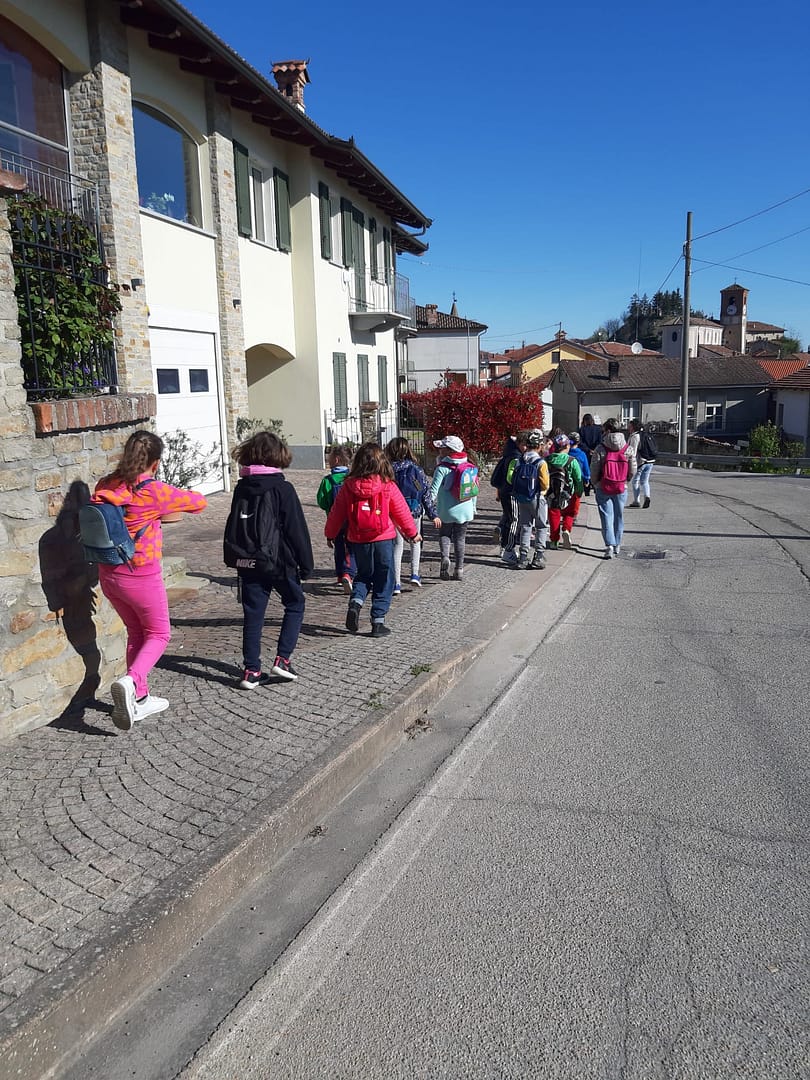by Marina Sacchetto, Virginia Baricalla, Valentina Cagnasso, Cristina Sibona
Highlights
- Schools play a pivotal role in instilling healthy habits in connection with nature
- The “Muovinsieme” project at the IC Bossolasco Murazzano school :how educational institutions can embrace the importance of movement in nature
- Teachers play a crucial role integrating movement in nature into the daily routine
In an increasingly hectic world, it is essential to focus on the psychophysical well-being of children from their early school years. Movement in nature, especially in the woods of the Alta Langa region, should not be seen merely as physical activity but as a key element for cognitive and emotional development. Introducing healthy habits in a natural environment is crucial for a balanced lifestyle and preventing potential health issues.
The benefits of movement in nature on children’s mental health are well-established. Regular physical exercise in natural settings not only reduces stress but also enhances mood and concentration more significantly than indoor activities. Integrating movement in nature into the daily school routine creates an environment that supports not only physical growth but also emotional and cognitive development. A healthy body often translates to a healthy mind.
 Schools play a pivotal role in instilling healthy habits in connection with nature. Education should not be confined to academics but should extend to comprehensive training that includes psychophysical well-being. Through movement in nature, children learn to manage stress, face challenges, and develop a positive connection with their bodies in a broader and rejuvenating environment.
Schools play a pivotal role in instilling healthy habits in connection with nature. Education should not be confined to academics but should extend to comprehensive training that includes psychophysical well-being. Through movement in nature, children learn to manage stress, face challenges, and develop a positive connection with their bodies in a broader and rejuvenating environment.
The “Muovinsieme” project https://www.muovinsieme.dors.it/ at the IC Bossolasco Murazzano school is an example of how educational institutions can embrace the importance of movement in nature. This initiative aims to walk regularly in the woods and Alta Langa during school time, covering at least a mile or walking for 20-30 minutes almost every day. It not only promotes physical activity but also provides children with the opportunity to connect with nature, experiencing its benefits for their psychophysical well-being.
Walking together in nature becomes a moment of sharing and leisure, contributing to building positive bonds among students in a quieter and more stimulating environment. Exploring the natural surroundings stimulates curiosity and a sense of belonging to the community, bringing children closer to the surrounding natural heritage. The “Muovinsieme” project is not just physical activity; it is an opportunity to teach children the importance of connecting with their bodies and with nature.
 Teachers play a crucial role in implementing such initiatives. They must be aware of the importance of integrating movement in nature into the daily routine, even in the classroom. Active breaks, outdoor games, and activities in natural settings can become integral parts of the school program. This way, the school becomes a place where children not only acquire academic knowledge but also learn to take care of their well-being through a connection with nature.
Teachers play a crucial role in implementing such initiatives. They must be aware of the importance of integrating movement in nature into the daily routine, even in the classroom. Active breaks, outdoor games, and activities in natural settings can become integral parts of the school program. This way, the school becomes a place where children not only acquire academic knowledge but also learn to take care of their well-being through a connection with nature.
 Implementing initiatives like “Muovinsieme” requires collective commitment from teachers, parents, and the community. Positive results are tangible not only in the improvement of physical health but also in increased motivation and academic performance. This approach, focusing on psychophysical well-being through movement in nature, proves effective in shaping balanced and aware individuals, investing in their future.
Implementing initiatives like “Muovinsieme” requires collective commitment from teachers, parents, and the community. Positive results are tangible not only in the improvement of physical health but also in increased motivation and academic performance. This approach, focusing on psychophysical well-being through movement in nature, proves effective in shaping balanced and aware individuals, investing in their future.




